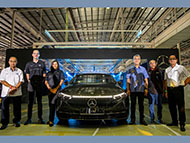By Lee Pang Seng
MERCEDES-Benz Malaysia is fully committed to its EV (electrical vehicle) ambitions here by kicking off the local assembly of its first EQ model, the EQS 500 4MATIC, at its Pekan, Pahang facility. And starting from the very top in the model range is a clear sign that more EQ models down the line would join the CKD (complete knock down) wagon soon enough.
While no production volume is set with this latest venture, Mercedes-Benz Malaysia says that it would be a market driven initiative. As long as there is demand, CKD production of the EQS would continue to meet the sales order book. If you aren’t familiar with the Mercedes-Benz EQ range, the EQS is the BEV (battery electrical vehicle) version of the flagship S-Class.
The EQS 500 takes over from the imported EQS 450 and would be the only flagship EV model available locally. With the government’s incentives of no sales tax and lower price CKD parts, the EQS 500 is about RM50,000 cheaper than the EQS 450 at RM648,888 on the road without insurance. That puts it competitively priced against the non-EV S-Class to make it an ideal alternative for the well-off in showing their passion for cleaner motoring.
It is also has more power on tap against the EQS 450 with a rated output of 330kW (449hp) and 828Nm of torque. With so much torque available from the get-go, it is not surprising that the EQS 500 could sprint from rest to 100km/h in a respectable 4.8 seconds. Top speed, however, is capped at 210km/h.
Given that an EV’s weight is determined very much by the large battery, the EQS tips the scales at 2615kg. That’s easily 600kg plus heavier than the non-EV S-Class. Even so, the EQS 500 has pretty good electric range on a full charge – 580-696km (WTLP or Worldwide Harmonised Light Vehicle Test Procedure).
The variance in range is determined by how the EQS 500 is driven and the use of equipment on board, such as the air-conditioning. The faster the car is driven, the shorter the range. Battery recharging happens when one slows down or uses the brakes, but little of these happens on highway driving. Until carmakers could come up with a way to recharge the battery during highway driving, the EV range would depend very much on how the accelerator is used.
We had a first-hand experience in range anxiety while driving the EQC 400 4MATIC to Kuantan. Mercedes-Benz Malaysia had arranged a media drive involving its local range of EQS models in conjunction with the EQS 500 CKD launch. Other than the EQC, there were the EQA 350, EQB 350, EQE 350 and EQS 450.
From the Mercedes-Benz Malaysia headquarters in Puchong, our next stop was at Petronas Gambang, about 60km from Kuantan. The company had teamed up with Petronas to instal three charging stations at that station and three more at the Petronas station across the highway for those heading towards KL; that is six in total.
We found that the faster we drove, the quicker the range mileage dropped. The EQC 400 was capable of 180km/h but we had to discipline ourself in driving a lot slower to manage the range distance. Our range anxiety was in making sure we could reach the Petronas Gambang charging station.
The EQC 400 is pretty powerful with 300kW (408hp) and 760Nm. It would sprint from 0 to 100km/h in 5.8 seconds and a top speed capped at 180km/h. Its given electric range from a full charge is 373 to 437km (WTLP). It is priced at RM388,888 on the road without insurance. When we took off from Mercedes-Benz Puchong, we had 397km in electric range. When we got to Petronas Gambang or having driven about 200km plus, our remaining range was 99km.
Driving in normal city traffic and the peak hour evening traffic in Kuantan later, the range was quite stable. It certainly didn’t fall off as quickly as when we were driving the EQC 400 at robust speeds on the highway. Cruise control driving was recommended as it would stabilise range distance but as we were not keen on using this system, we used our accelerator foot to manage that. Needless to say, this EQC 400 drive was the slowest we had done in a Mercedes-Benz media event.
As there were almost 20 vehicles in the media EQ drive, each vehicle was given a 15-minute charge to save time. A quick charge to achieve 80-per cent battery level would take about 35 minutes but that would have taken double the charging time for this big group. The only exception was the longer range EQS 450 as it still had sufficient range to reach Kuantan comfortably.
That 15-minute charge gave us about 110km plus, which was more than sufficient for us to reach Hyatt Kuantan. The EQs had to be recharged again the following day at the KL-bound Petronas Gambang station. But we opted for a change of vehicle to the non-EV A250 to enjoy the drive back to Mercedes-Benz Puchong without this range anxiety hanging over our head.
Perhaps, if there were more EV charging points along the way, we would have enjoyed the Mercedes-Benz EQ drive a lot more. The government’s ambition to install an additional 10,000 charging points across the country by 2025 would certainly ease this range anxiety for EV owners to fully enjoy their highway drives.




















